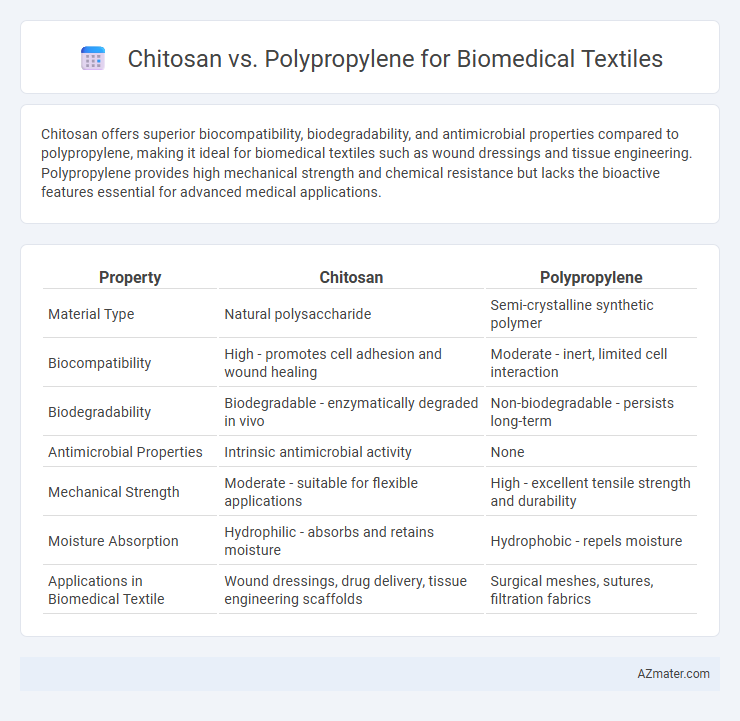Chitosan offers superior biocompatibility, biodegradability, and antimicrobial properties compared to polypropylene, making it ideal for biomedical textiles such as wound dressings and tissue engineering. Polypropylene provides high mechanical strength and chemical resistance but lacks the bioactive features essential for advanced medical applications.
Table of Comparison
| Property | Chitosan | Polypropylene |
|---|---|---|
| Material Type | Natural polysaccharide | Semi-crystalline synthetic polymer |
| Biocompatibility | High - promotes cell adhesion and wound healing | Moderate - inert, limited cell interaction |
| Biodegradability | Biodegradable - enzymatically degraded in vivo | Non-biodegradable - persists long-term |
| Antimicrobial Properties | Intrinsic antimicrobial activity | None |
| Mechanical Strength | Moderate - suitable for flexible applications | High - excellent tensile strength and durability |
| Moisture Absorption | Hydrophilic - absorbs and retains moisture | Hydrophobic - repels moisture |
| Applications in Biomedical Textile | Wound dressings, drug delivery, tissue engineering scaffolds | Surgical meshes, sutures, filtration fabrics |
Introduction to Biomedical Textiles
Biomedical textiles integrate advanced materials like chitosan and polypropylene to enhance tissue engineering and wound care applications. Chitosan, a natural biopolymer derived from chitin, offers excellent biocompatibility, biodegradability, and antimicrobial properties, making it ideal for wound dressings and drug delivery systems. Polypropylene, a synthetic polymer, provides mechanical strength, chemical resistance, and durability, commonly used in surgical meshes and implantable fabrics.
Overview of Chitosan: Properties and Applications
Chitosan is a biocompatible, biodegradable polysaccharide derived from chitin, widely used in biomedical textiles for its antimicrobial, hemostatic, and wound healing properties. Its natural cationic nature enables strong interactions with biological tissues, promoting cell adhesion and tissue regeneration. Applications include wound dressings, drug delivery systems, and tissue engineering scaffolds, distinguishing it from synthetic polypropylene with superior biofunctionality and environmental sustainability.
Polypropylene in Biomedical Textiles: Key Features
Polypropylene in biomedical textiles offers exceptional biocompatibility, chemical resistance, and durability, making it ideal for surgical gowns, masks, and wound dressings. Its hydrophobic nature prevents bacterial adhesion and fluid absorption, enhancing infection control. Lightweight and cost-effective, polypropylene supports mass production while maintaining high-performance standards in medical applications.
Biocompatibility Comparison: Chitosan vs Polypropylene
Chitosan exhibits superior biocompatibility compared to polypropylene due to its natural origin, biodegradability, and ability to promote cell adhesion and proliferation, making it ideal for wound dressings and tissue engineering applications. Polypropylene, while widely used for its strength and durability, often induces a foreign body response and lacks the bioactive properties critical for seamless tissue integration. Studies demonstrate that chitosan's inherent antimicrobial and anti-inflammatory properties significantly enhance its performance in biomedical textiles, surpassing polypropylene in biocompatibility metrics.
Mechanical Strength and Durability Analysis
Chitosan offers excellent biocompatibility and antimicrobial properties but generally exhibits lower mechanical strength and durability compared to polypropylene in biomedical textiles. Polypropylene demonstrates superior tensile strength, flexibility, and resistance to wear, making it more suitable for long-term applications requiring high mechanical durability. The integration of chitosan coatings on polypropylene substrates can enhance biofunctionality without significantly compromising the mechanical performance essential for durable biomedical textiles.
Antimicrobial and Bioactivity Performance
Chitosan exhibits superior antimicrobial properties compared to polypropylene due to its natural polycationic structure, which disrupts microbial cell membranes effectively. Its bioactive nature promotes wound healing and tissue regeneration, making it highly suitable for biomedical textile applications. Polypropylene, while mechanically robust, lacks intrinsic antimicrobial activity and bioactivity, limiting its functionality in infection control and tissue interaction contexts.
Environmental Impact and Biodegradability
Chitosan, derived from natural sources like crustacean shells, offers superior biodegradability and environmental benefits compared to polypropylene, which is a petroleum-based synthetic polymer known for its persistence in the environment. The biodegradation of chitosan reduces microplastic pollution and lowers the carbon footprint of biomedical textiles, promoting sustainability in medical applications. In contrast, polypropylene's resistance to biodegradation contributes to long-term environmental contamination and challenges in waste management within healthcare settings.
Processing and Fabrication Techniques
Chitosan offers versatile processing techniques such as electrospinning, freeze-drying, and solvent casting, enabling the fabrication of biocompatible and biodegradable biomedical textiles with controlled porosity. Polypropylene is predominantly processed through melt spinning and extrusion, resulting in non-biodegradable, mechanically robust fibers ideal for durable biomedical applications like surgical meshes. The choice between chitosan and polypropylene hinges on balancing biodegradability and bioactivity with mechanical strength and fabrication scalability in biomedical textile manufacturing.
Cost-Effectiveness and Scalability
Chitosan offers superior biocompatibility and antimicrobial properties making it highly effective for biomedical textiles, though its production cost remains higher due to complex extraction and purification processes. Polypropylene provides cost-effective scalability with well-established manufacturing techniques, allowing mass production at a lower price point, but lacks inherent bioactivity and biodegradability. Balancing cost-effectiveness and scalability, polypropylene remains favored for large-scale applications, whereas chitosan is preferred when enhanced biological functionality justifies the investment.
Future Trends and Innovations in Biomedical Textiles
Chitosan's biodegradability and antimicrobial properties position it as a leading material in future biomedical textiles, fostering innovations in wound healing and tissue engineering. Polypropylene remains valuable for its durability and cost-effectiveness but faces challenges in biocompatibility, driving research toward functionalizing its surface for enhanced biomedical applications. Emerging trends emphasize hybrid composites combining chitosan and polypropylene to leverage biodegradability with mechanical strength for next-generation implantable and wearable medical devices.

Infographic: Chitosan vs Polypropylene for Biomedical textile
 azmater.com
azmater.com